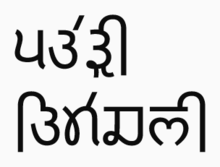Western Pahari
The Himachali or Western Pahari languages are a group of Northern Indo-Aryan languages spoken in the western parts of the Himalayan range, predominantly in the Indian state of Himachal Pradesh, but also in parts of some neighbouring regions.
| Western Pahari | |
|---|---|
| Himachali | |
| Geographic distribution | India (Himachal Pradesh) |
| Linguistic classification | Indo-European
|
| ISO 639-2 / 5 | him |
| Glottolog | hima1250[1] |
They are sometimes referred to as the Himachali languages (not to be confused with the Languages of Himachal Pradesh, some of which do not belong to this group). They are also often called simply Pahari, but this name is ambiguous as it used for other languages as well, including some other Northern Indo-Aryan languages of Uttarakhand and Nepal, as well as the Pahari of western Kashmir.

Languages
The following lists the languages classified as belonging to Western Pahari, with the provisional grouping used in Glottolog 4.1:[2]
- Jaunsari
- Nuclear Himachali:
- Hinduri
- Pahari Kinnauri
- Kullu Pahari
- Mahasu Pahari
- Sirmauri
- Mandeali
- Kangric-Chamealic-Bhattiyali:
These languages are a dialect chain, and neighbouring varieties may be mutually intelligible. Some Western Pahari languages have occasionally been regarded as dialects of either Dogri, Hindustani or Punjabi.
Some Western Pahari languages, notably Dogri and Kangri, are tonal, like their close relative Punjabi but unlike most other Indic languages. Dogri has been an official language in India since 2003.
A controversial theory, put forward by linguist Claus Peter Zoller, suggests that the Bangani language is closely related (or a part of) the Western Pahari languages, and has been misclassified as one of the Garhwali languages.
Writing systems
If written at all, the Western Pahari languages typically employ the Devanagari script.
In the past, some of these languages were written in the Takri script.[3] It rapidly fell out of use after Independence, even though there have since been sporadic attempts to revive it.[4]
Status
According to the United Nations Education, Scientific and Cultural Organisation (UNESCO), all of Western Pahari languages, except for Dogri, are under either definitely endangered or critically endangered category.[5] None of these languages, except for Dogri, have any official status.
The demand for the inclusion of 'Pahari (Himachali)' under the Eight Schedule of the Constitution, which is supposed to represent multiple Pahari languages of Himachal Pradesh, had been made in the year 2010 by the state's Vidhan Sabha. There has been no positive progress on this matter since then even when small organisations are taking upto themselves to save the language and demanding it. Due to political interest, the language is currently recorded as a dialect of Hindi, even when having a poor mutual intelligibility with it and having a higher mutual intelligibility with other recognised languages like Dogri.
References
- Hammarström, Harald; Forkel, Robert; Haspelmath, Martin, eds. (2017). "Himachali". Glottolog 3.0. Jena, Germany: Max Planck Institute for the Science of Human History.
- "Family: Himachali". Glottolog 4.1.
- "Tankri once the language of royals, is now dying in Himachal Pradesh - Hindustan times". Archived from the original on 2 February 2017. Retrieved 25 January 2017.
- "Ancient scripts of Indian Mountains fights for survival - Zee News". Retrieved 9 January 2017.
- "Endangered languages".
Bibliography
- Masica, Colin P. (1991). The Indo-Aryan languages. Cambridge language surveys. Cambridge University Press. ISBN 978-0-521-23420-7.CS1 maint: ref=harv (link)
External links
- Map of Western Pahari languages from Grierson's early 20th-century Linguistic Survey of India